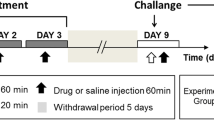Abstract
Crack cocaine users are simultaneously exposed to volatilized cocaine and to its main pyrolysis product, anhydroecgonine methyl ester (AEME). Although the neurotoxic effects of cocaine have been extensively studied, little is known about AEME or its combination. We investigated cell death processes using rat primary hippocampal cells exposed to cocaine (2 mM), AEME (1 mM) and their combination (C + A), after 1, 3, 6 and 12 h. Cocaine increased LC3 I after 6 h and LC3 II after 12 h, but reduced the percentage of cells with acid vesicles, suggesting failure in the autophagic flux, which activated the extrinsic apoptotic pathway after 12 h. AEME neurotoxicity did not involve the autophagic process; rather, it activated caspase-9 after 6 h and caspase-8 after 12 h leading to a high percentage of cells in early apoptosis. C + A progressively reduced the percentage of undamaged cells, starting after 3 h; it activated both apoptotic pathways after 6 h, and was more neurotoxic than cocaine and AEME alone. Also, C + A increased the phosphorylation of p62 after 12 h, but there was little difference in LC3 I or II, and a small percentage of cells with acid vesicles at all time points investigated. In summary, the present study provides new evidence for the neurotoxic mechanism and timing response of each substance alone and in combination, indicating that AEME is more than just a biological marker for crack cocaine consumption, as it may intensify and hasten cocaine neurotoxicity.








Similar content being viewed by others
References
Almeida PP, de Araujo Filho GM, Malta SM et al (2017) Attention and memory deficits in crack-cocaine users persist over four weeks of abstinence. J Subst Abuse Treat 81:73–78. https://doi.org/10.1016/j.jsat.2017.08.002
An H-K, Chung KM, Park H et al (2019) CASP9 (caspase 9) is essential for autophagosome maturation through regulation of mitochondrial homeostasis. Autophagy. https://doi.org/10.1080/15548627.2019.1695398
Areal LB, Herlinger AL, Pelição FS, Martins-Silva C, Pires RGW (2017) Crack cocaine inhalation induces schizophrenia-like symptoms and molecular alterations in mice prefrontal cortex. J Psychiatr Res 91:57–63. https://doi.org/10.1016/j.jpsychires.2017.03.005
Avila J, Llorens-Martín M, Pallas-Bazarra N et al (2017) Cognitive decline in neuronal aging and Alzheimer’s disease: role of NMDA receptors and associated proteins. Front Neurosci 11:626–626. https://doi.org/10.3389/fnins.2017.00626
Badisa RB, Wi S, Jones Z et al (2018) Cellular and molecular responses to acute cocaine treatment in neuronal-like N2a cells: potential mechanism for its resistance in cell death. Cell Death Discov 4(1):76. https://doi.org/10.1038/s41420-018-0078-x
Bialik S, Dasari SK, Kimchi A (2018) Autophagy-dependent cell death—where, how and why a cell eats itself to death. J Cell Sci 131(18):jcs215152. https://doi.org/10.1242/jcs.215152
Blesa J, Trigo-Damas I, Quiroga-Varela A, Jackson-Lewis VR (2015) Oxidative stress and Parkinson’s disease. Front Neuroanat 9:91–91. https://doi.org/10.3389/fnana.2015.00091
Butler AJ, Rehm J, Fischer B (2017) Health outcomes associated with crack-cocaine use: systematic review and meta-analyses. Drug Alcohol Depend 180:401–416. https://doi.org/10.1016/j.drugalcdep.2017.08.036
Button RW, Roberts SL, Willis TL, Hanemann CO, Luo S (2017) Accumulation of autophagosomes confers cytotoxicity. J Biol Chem 292(33):13599–13614. https://doi.org/10.1074/jbc.M117.782276
Castiglioni S, Zuccato E, Chiabrando C, Fanelli R, Bagnati R (2008) Mass spectrometric analysis of illicit drugs in wastewater and surface water. Mass Spectrom Rev 27(4):378–394. https://doi.org/10.1002/mas.20168
Chan FK-M, Moriwaki K, De Rosa MJ (2013) Detection of necrosis by release of lactate dehydrogenase activity. Methods Mol Biol 979:65–70. https://doi.org/10.1007/978-1-62703-290-2_7
Cone EJ (1995) Pharmacokinetics and pharmacodynamics of cocaine. J Anal Toxicol 19(6):459–478
de Jong K, Rettig MP, Low PS, Kuypers FA (2002) Protein Kinase C activation induces phosphatidylserine exposure on red blood cells. Biochemistry 41(41):12562–12567. https://doi.org/10.1021/bi025882o
Dey S, Mactutus CF, Booze RM, Snow DM (2007) Cocaine exposure in vitro induces apoptosis in fetal locus coeruleus neurons by altering the Bax/Bcl-2 ratio and through caspase-3 apoptotic signaling. Neuroscience 144(2):509–521. https://doi.org/10.1016/j.neuroscience.2006.09.047
EMCDDA (2015) European Drug Report: trends and Developments. EMCDDA—European Monitoring Center for Drugs and Drug Addiction, Publications Office of the European Union
Garcia RCT, Dati LM, Fukuda S et al (2012) Neurotoxicity of anhydroecgonine methyl ester, a crack cocaine pyrolysis product. Toxicol Sci 128(1):223–234. https://doi.org/10.1093/toxsci/kfs140
Garcia RCT, Dati LM, Torres LH et al (2015) M1 and M3 muscarinic receptors may play a role in the neurotoxicity of anhydroecgonine methyl ester, a cocaine pyrolysis product. Sci Rep 5:17555. https://doi.org/10.1038/srep17555
Garcia RCT, Torres LL, Dati LMM et al (2019) Anhydroecgonine methyl ester (AEME), a cocaine pyrolysis product, impairs glutathione-related enzymes response and increases lipid peroxidation in the hippocampal cell culture. Toxicol Rep 6:1223–1229. https://doi.org/10.1016/j.toxrep.2019.11.001
Giorgi C, Agnoletto C, Bononi A et al (2012) Mitochondrial calcium homeostasis as potential target for mitochondrial medicine. Mitochondrion 12(1):77–85. https://doi.org/10.1016/j.mito.2011.07.004
Gomes EF, Lipaus IFS, Martins CW et al (2018) Anhydroecgonine methyl ester (AEME), a product of cocaine pyrolysis, impairs spatial working memory and induces striatal oxidative stress in Rats. Neurotox Res 34(4):834–847. https://doi.org/10.1007/s12640-017-9813-y
Gonçalves JR, Nappo SA (2015) Factors that lead to the use of crack cocaine in combination with marijuana in Brazil: a qualitative study. BMC Public Health 15:706. https://doi.org/10.1186/s12889-015-2063-0
Guha P, Harraz MM, Snyder SH (2016) Cocaine elicits autophagic cytotoxicity via a nitric oxide-GAPDH signaling cascade. Proc Natl Acad Sci 113(5):1417. https://doi.org/10.1073/pnas.1524860113
Haga T (2013) Molecular properties of muscarinic acetylcholine receptors. Proc Jpn Acad Ser B Phys Biol Sci 89(6):226–256. https://doi.org/10.2183/pjab.89.226
Huang X, Gu HH, Zhan C-G (2009) Mechanism for cocaine blocking the transport of dopamine: insights from molecular modeling and dynamics simulations. J Phys Chem B 113(45):15057–15066. https://doi.org/10.1021/jp900963n
Javaid JI, Fischman MW, Schuster CR, Dekirmenjian H, Davis JM (1978) Cocaine plasma concentration: relation to physiological and subjective effects in humans. Science 202(4364):227
Jenkins AJ, Keenan RM, Henningfield JE, Cone EJ (2002) Correlation beteween pharmacological effects and plasma cocaine concentrations after smoked administration. J Anal Toxicol 26:383–392
Kania E, Roest G, Vervliet T, Parys JB, Bultynck G (2017) IP(3) receptor-mediated calcium signaling and its role in autophagy in cancer. Front Oncol 7:140–140. https://doi.org/10.3389/fonc.2017.00140
Klionsky DJ, Abdelmohsen K, Abe A et al (2016) Guidelines for the use and interpretation of assays for monitoring autophagy (3rd edition). Autophagy 12(1):1–222. https://doi.org/10.1080/15548627.2015.1100356
Klotz L-O, Steinbrenner H (2017) Cellular adaptation to xenobiotics: Interplay between xenosensors, reactive oxygen species and FOXO transcription factors. Redox Biol 13:646–654. https://doi.org/10.1016/j.redox.2017.07.015
Lepsch LB, Munhoz CD, Kawamoto EM et al (2009) Cocaine induces cell death and activates the transcription nuclear factor kappa-b in pc12 cells. Mol Brain 2(1):3. https://doi.org/10.1186/1756-6606-2-3
Lepsch LB, Planeta CS, Scavone C (2015) Cocaine causes apoptotic death in rat mesencephalon and striatum primary cultures. Biomed Res Int 2015:750752. https://doi.org/10.1155/2015/750752
Mai HN, Sharma N, Jeong JH et al (2019) P53 knockout mice are protected from cocaine-induced kindling behaviors via inhibiting mitochondrial oxidative burdens, mitochondrial dysfunction, and proapoptotic changes. Neurochem Int 124:68–81. https://doi.org/10.1016/j.neuint.2018.12.017
Mattiolo P, Yuste VJ, Boix J, Ribas J (2015) Autophagy exacerbates caspase-dependent apoptotic cell death after short times of starvation. Biochem Pharmacol 98(4):573–586. https://doi.org/10.1016/j.bcp.2015.09.021
Mosior M, Epand RM (1993) Mechanism of activation of protein kinase C: roles of diolein and phosphatidylserine. Biochemistry 32(1):66–75. https://doi.org/10.1021/bi00052a010
Nakahara Y, Ishigami A (1991) Inhalation efficiency of free-base cocaine by pyrolysis of ‘Crack’ and cocaine hydrochloride. J Anal Toxicol 15(3):105–109. https://doi.org/10.1093/jat/15.3.105
Nikoletopoulou V, Markaki M, Palikaras K, Tavernarakis N (2013) Crosstalk between apoptosis, necrosis and autophagy. Biochem Biophys Acta 12:3448–3459. https://doi.org/10.1016/j.bbamcr.2013.06.001
Oliveira HP, Gonçalves PD, Ometto M et al (2018) The route of administration exacerbates prefrontal functional impairments in crack cocaine users. Psychol Addict Behav 32(7):812–820. https://doi.org/10.1037/adb0000410
Oliveira MT, Rego AC, Macedo TA, Oliveira CR (2003) Drugs of abuse induce apoptotic features in PC12 cells. Ann N Y Acad Sci 1010(1):667–670. https://doi.org/10.1196/annals.1299.121
Perez-Reyes M, Di Guiseppi S, Ondrusek G, Jeffcoat AR, Cook CE (1982) Free-base cocaine smoking. Clin Pharmacol Ther 32(4):459–465. https://doi.org/10.1038/clpt.1982.189
PubChem (2015) PubChem Database. Methylecgonidine CID=119478. In: National Center for Biotechnology Information. https://pubchem.ncbi.nlm.nih.gov/compound/119478. Accessed 5 Feb 2015
Reynolds DS, Carter RJ, Morton AJ (1998) Dopamine modulates the susceptibility of striatal neurons to 3-nitropropionic acid in the rat model of Huntington’s Disease. J Neurosci 18(23):10116. https://doi.org/10.1523/JNEUROSCI.18-23-10116.1998
Scheidweiler KB, Plessinger MA, Shojaie J, Wood RW, Kwong TC (2003) Pharmacokinetics and pharmacodynamics of methylecgonidine, a crack cocaine pyrolyzate. J Pharmacol Exp Ther 307(3):1179
So EC, Huang YM, Hsing CH, Liao YK, Wu SN (2015) Arecoline inhibits intermediate-conductance calcium-activated potassium channels in human glioblastoma cell lines. Eur J Pharmacol 758:177–187. https://doi.org/10.1016/j.ejphar.2015.03.065
Sudai E, Croitoru O, Shaldubina A et al (2011) High cocaine dosage decreases neurogenesis in the hippocampus and impairs working memory. Addict Biol 16(2):251–260. https://doi.org/10.1111/j.1369-1600.2010.00241.x
Thomé MP, Filippi-Chiela EC, Villodre ES et al (2016) Ratiometric analysis of acridine orange staining in the study of acidic organelles and autophagy. J Cell Sci 129(24):4622–4632. https://doi.org/10.1242/jcs.195057
Torres LH, Balestrin NT, Spelta LEW, Duro SdO, Pistis M, Marcourakis T (2019) Exposure to tobacco smoke during the early postnatal period modifies receptors and enzymes of the endocannabinoid system in the brainstem and striatum in mice. Toxicol Lett 302:35–41. https://doi.org/10.1016/j.toxlet.2018.12.002
Tran S-L, Puhar A, Ngo-Camus M, Ramarao N (2011) Trypan blue dye enters viable cells incubated with the pore-forming Toxin HlyII of Bacillus cereus. PLoS ONE 6(9):e22876. https://doi.org/10.1371/journal.pone.0022876
UNODC (2019) World Drug Report 2019, vol Booklet 4. E.19.XI.8. United Nation publications
Vanden Berghe T, Grootjans S, Goossens V et al (2013) Determination of apoptotic and necrotic cell death in vitro and in vivo. Methods 61(2):117–129. https://doi.org/10.1016/j.ymeth.2013.02.011
Vázquez D, Pribut HJ, Burton AC, Tennyson SS, Roesch MR (2020) Prior cocaine self-administration impairs attention signals in anterior cingulate cortex. Neuropsychopharmacology 45(5):833–841. https://doi.org/10.1038/s41386-019-0578-2
Verma V (2015) Classic studies on the interaction of cocaine and the dopamine transporter. Clin Psychopharmacol Neurosci 13(3):227–238. https://doi.org/10.9758/cpn.2015.13.3.227
Vermes I, Haanen C, Steffens-Nakken H, Reutelingsperger C, Reutellingsperger C (1995) A novel assay for apoptosis. Flow cytometric detection of phosphatidylserine expression on early apoptotic cells using fluorescein labelled Annexin V. J Immunol Methods 184(1):39–51. https://doi.org/10.1016/0022-1759(95)00072-i
Viswanath V, Wu Y, Boonplueang R et al (2001) Caspase-9 activation results in downstream caspase-8 activation and bid cleavage in 1-methyl-4-phenyl-1,2,3,6-tetrahydropyridine-induced Parkinson’s disease. J Neurosci 21(24):9519. https://doi.org/10.1523/JNEUROSCI.21-24-09519.2001
Xiao D, Zhang L (2008) Upregulation of Bax and Bcl-2 following prenatal cocaine exposure induces apoptosis in fetal rat brain. Int J Med Sci 5(6):295–302. https://doi.org/10.7150/ijms.5.295
Zhang Y, Chen X, Gueydan C, Han J (2018) Plasma membrane changes during programmed cell deaths. Cell Res 28(1):9–21. https://doi.org/10.1038/cr.2017.133
Acknowledgements
The authors acknowledge Dr. Sandra Farsky and her students Lorena Pantaleão and Gustavo Rocha from the Department of Clinical and Toxicological Analysis, School of Pharmaceutical Sciences, University of São Paulo, for their advice on flow cytometry protocols, and Dr. Felipe Augusto Dörr, from the same institution, for his technical assistance with the drugs’ LC–MS/MS analysis.
Funding
This research was funded by the Fundação de Amparo à Pesquisa do Estado de São Paulo (FAPESP—student grant: 2013/20952-6 and research support: 2014/08881-9) and by the Conselho Nacional de Desenvolvimento Científico e Tecnológico (CNPq—159886/2013-9). T.M. and S.S.M.E are research fellows of CNPq.
Author information
Authors and Affiliations
Corresponding author
Ethics declarations
Conflict of interest
The authors declare no competing financial interests.
Ethics approval
This study was performed according to National Institutes of Health guidelines and approved by the Animal Experimentation Ethics Committee of the School of Pharmaceutical Sciences (no. 100.2014) and School of Veterinary Medicine and Animal Science (no. 5737050814), at the University of São Paulo.
Availability of data and material
All data generated or analysed during the current study are included in this article.
Additional information
Publisher's Note
Springer Nature remains neutral with regard to jurisdictional claims in published maps and institutional affiliations.
Rights and permissions
About this article
Cite this article
Udo, M.S.B., da Silva, M.A.A., de Souza Prates, S. et al. Anhydroecgonine methyl ester, a cocaine pyrolysis product, contributes to cocaine-induced rat primary hippocampal neuronal death in a synergistic and time-dependent manner. Arch Toxicol 95, 1779–1791 (2021). https://doi.org/10.1007/s00204-021-03017-z
Received:
Accepted:
Published:
Issue Date:
DOI: https://doi.org/10.1007/s00204-021-03017-z




